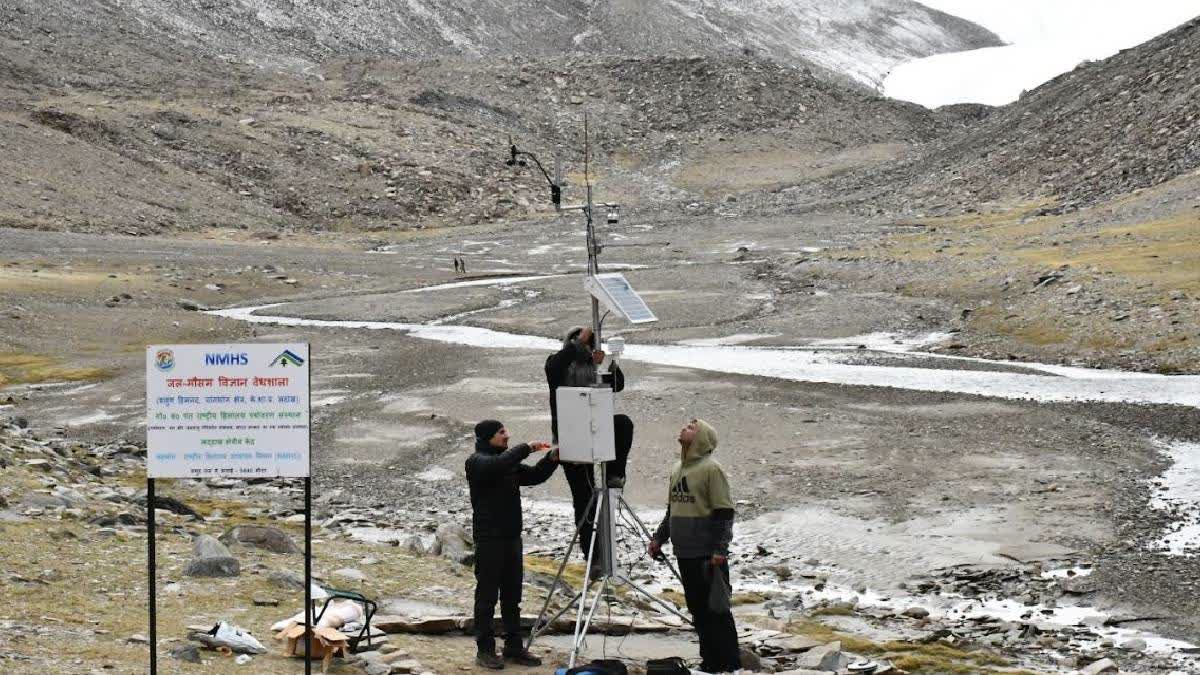Srinagar (Jammu and Kashmir): In a major step to understand and manage the vital glacier systems of the Indian Himalayas, the GB Pant National Institute of Himalayan Environment (NIHE) has established a new Hydro-Meteorological Observatory on the Rulung Glacier in the Changthang region of Ladakh.
This initiative, launched under the National Mission on Himalayan Studies (NMHS) by the Ministry of Environment, Forest and Climate Change (MoEF&CC), aims to provide critical data on glacier dynamics and their impact on regional water systems.
While speaking to ETV Bharat, Dr. Purushottam Kumar Garg, Scientist (R&D) at the Ladakh Regional Centre of NIHE, detailed the project's importance. “The Himalaya-Karakoram region amasses the largest glacier cover outside the polar region, which plays a crucial role in regulating the hydrology of major river systems like the Indus, Ganges, and Brahmaputra. Approximately one billion people rely on the water these glaciers release.”
The project, titled “Assessment of Glacier-Climate Functional Relationships Across the Indian Himalayan Region Through Long-Term Network Observations,” involves a comprehensive assessment of glacial dynamics, morphometry, hydrodynamics, melt-water chemistry, and mass balance within the Indus, Ganges, and Brahmaputra basins.
The Rulung Glacier, situated in Ladakh’s Changthang region, was chosen for its long-term field-based monitoring. Ladakh represents about 50 percent of India’s total glacier wealth. Despite its importance, Ladakh remains one of the least studied regions in terms of glaciological research.
“Ladakh is a vital area for glacier studies, yet it has been under-researched. Our goal is to bridge this gap with comprehensive, long-term observations,” Dr. Garg, who is also the invigilator project, said.
The project began with an expedition to the Rulung Glacier in October 2023, during which initial glaciological mass balance measurements were taken and sites for monitoring equipment were identified. The second expedition, conducted from late July to early August 2024, saw the installation of an Automatic Weather Station (AWS) at an altitude of approximately 5600 meters above sea level. “The AWS is equipped with sophisticated sensors to measure wind speed and direction, snow depth, radiation, albedo, air temperature, and relative humidity,” Dr. Garg explained.
Additionally, a discharge measurement site was established with an Automatic Water Level Recorder (AWLR) to monitor meltwater stream discharge. Dr. Garg noted, “The Hydro-Meteorological Observatory consists of the AWS and AWLR. These tools will record meteorological parameters and water level fluctuations in real-time, with all data logged for further analysis.”
The establishment of this observatory, supported by NMHS and MoEF&CC, marks a significant advancement in high-altitude monitoring. Notably, the Rulung Glacier observatory is among the highest of its kind in Ladakh, alongside other prominent observatories such as those on the Siachen Glacier and in the Pangong Tso region.
Summarising the project's goals, Dr. Garg said, “The overarching aim is to acquire long-term, reliable data on glacier fluctuations and local meteorology. This data will help us develop a comprehensive understanding of glacier-climate relationships, which is essential for better water resource management in the region.”
Reflecting on the challenges faced during the project, Dr. Garg acknowledged the difficulties saying, “Field expeditions in high-altitude areas like Ladakh are incredibly challenging due to the inhospitable terrain, frequent bad weather, logistic constraints, and security issues. However, the support from local communities and the dedication of our team have been invaluable.”
The data collected will play a crucial role in the conservation and management of glacier resources, vital for the socio-economic stability of the region. “Our journey has been both adventurous and rewarding,” Dr. Garg said adding, “We aim to make glacier expeditions to the Rulung Glacier a routine activity, contributing to the long-term preservation of these irreplaceable resources.”
Read more



